
Welcome to the inaugural edition of my new series, The Randomizer. (Copyright 2015. All rights reserved. Do not read Randomizer if you are prone to dizzy spells or operating heavy machinery. No cash value. Void where prohibited. Offer not valid in Utah and Idaho. If not completely satisfied, return the unused portion with receipt for a full refund.)
You like my fancy banner? I made it myself? You don’t? Well then, if you can do better, then I would like to see it, thank you very much. No, seriously, if you want to make a better banner for my series, I would eternally grateful for it. Art was not exactly my best class in grade school.
So, what the hell is the Randomizer? Basically, it goes like this. I placed every game I own into a simple MySql database. My collections is over 600 games and constantly growing. Some of these games, I’ve beaten, some I’ve played very little, and some I have never played. Then I created a simple script using PHP. (Perl works too, but had issues connecting to the database.) I press a simple button, and it spits out a random game in my collection. Then, I must play it and review it. It’s just that easy
The idea of the series is to make choosing a game to review straight forward and more definitive. I have a lot of games in my backlog to take care of, and like some people, have absolutely no idea where to start. Now, I just have to go with the recommendations of luck. Gambling is one of my other hobbies, so it makes perfect sense to me.
Now with full disclosure in mind, I should explain that during the first little while, it’s programmed to display several choices, until I get a groove back into writing and reviewing, but I still must choose one of the selected games. Plus the random algorithm is set up so that I get more chances to get my older generation games. This is because I want this more to be a retro game series. But as we go along, it’s possible to get newer games, but I’ll deal with that as it gets closer. Also, any game I’ve previously reviewed on my blog has been removed from contention, because I’ve already reviewed it. Maybe down the road, I’ll cover them again, but for now, let’s do all fresh titles. Also, I have an idea that I’ll randomly select 2 or more titles and if this gets popular, I’ll let the audience select my next game.
Now only one real rule will apply to me to choose a game that was not selected. If the chosen game is a sequel, and I have not reviewed the original game, I can choose to review the original instead. So if I get Ninja Gaiden 2, and I want to review Ninja Gaiden instead, I can choose to. But, if I get Zelda: Wind Waker, I can’t review Legend of Zelda: A Link To The Past instead, because that’s on a different system. Same with Resident Evil 4 on my Gamecube, I can’t review Resident Evil 3, but if Resident Evil 3 is selected, I can choose Resident Evil 1 because they are both on the Playstation 1. I think that makes sense. I’ll probably make amendments to that rule as the different situations arise. If you have any other rules I should adjust and such, I’d be glad to hear them. Simply comment or email, or leave feedback in the section of my site.
But enough talk. Let’s push the button, and see what I get for the first ever review!
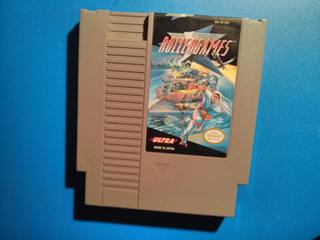
Hmm, what do we have here? Rollergames for the N.E.S. Ah, an excellent way to start this series. A fine game, this Rollergames. I remember Rollergames from my wild and crazy youth? The days of gallivanting around, skipping in meadows, and singing hymns of delight with Rollergames.
Wait, what in the ten thousand hells is a Rollergames?
Upon further researching, Rollergames was a television show from 1989 about a collection of roller skaters competing in groups by circling a roller rink for points. I’m guessing it was inspired by the 1975 science fiction classic (and one of my personal favourite movies of all time) Rollerball, and inspired the leagues that inspired the 2009 Drew Barrymore movie, Whip it. The television show was set up like World Wrestling Federation for roller skating, as there are blatant good guys and bad guys, and over the top stories were there to entertain the crowds watching at home. There are episodes on YouTube, and I have to say they are very fun to watch.
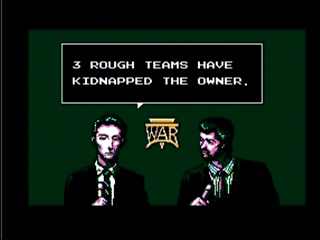
The show had the rink shaped into a figure 8, and the participants earned points either by passing people and getting high on a ramped wall. One of the skaters on each team was selected to try to skate up along a wall, almost like a half pipe, and the higher you get up that wall, the more points you earn. Then you hit a ramp and if you can get a certain distance from it while staying upright on landing, you earn more points. Then you try to pass as many people as you want for even more points. There are several rounds, alternating between men and women. The team with the highest points wins.
There was even a pit of alligators in the middle for a tie breaker. That last sentence is one hundred percent true. An alligator pit! Complete with real, live alligators. Check out the video, it’s insane. Needless to say, the eighties were a weird time to grow up in.
Even though the show got heavily panned by critics, the target demographic of teenage boys made it especially popular. The show did so well that during its time on television, even though it was on at the same time slot as Saturday Night Live, it had better ratings than American Gladiators. You’d think that the producers were so rich off the profits of such a successful show, they must have had mansions inside mansions and bikini-clad women as servants, right? Not exactly, they went bankrupt shortly after spending all their cash on production costs, and the show was pulled less than a year later in 1990. Personally, I would have tried to save money by not buying alligators.
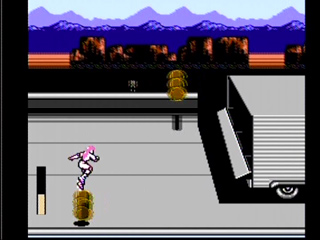
So yes, this game is based on that television show. This side-scrolling, beat-em-up platformer is based on a television show that was competing against American Gladiators. Why it wasn’t a Track And Field II style competition game is anyone’s guess. There was an arcade game as well, and apparently that game is more like the show, but I haven’t played it. Believe me when I say this, I’m glad it’s a platformer on the home console.
You’re probably wondering why I just spent so much time on the show, rather than the game. After all, the review is about the video game. I just couldn’t stop after I found this out. The history of the show and the actual show itself is so much fun to look into. Plus, sadly the show is much better than the in-game story. Apparently the heel teams help an underground criminal organization capture the general manager of the franchise, and it’s up to the crowd favourites to rescue him. That’s about it. Although if you read the story in the instructions, it’s just as silly. The two best points of the story is that the commissioner of the league’s name is Emerson “Skeeter” Bankhead, which sounds like a hip billionaire name, and that the underground criminal organization that are the main antagonists are named VIPER and that stands for Vicious International Punks and Eternal Renegade. This game has 80’s funk all over it.
The game was created by shell subsidiary company of Konami, Ultra Games, the same company that gave us the Teenage Mutant Ninja Turtles NES games, as well as Skate Or Die series. I mention both Ultra and Konami early into the review because I want you to remember that fact in the back of your head.
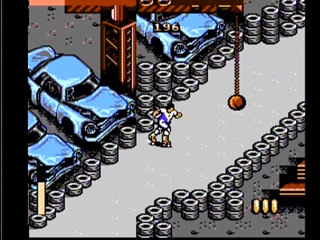
To be perfectly honest, I have never played this game, ever. I picked it up in a bundle of games, and it cost me maybe less than ten dollars. Somehow, like some of the games I own, I never played it further than the first level to make sure the game works, for testing purposes. So I’m almost going into the game blind. We’re on a crash course with wackiness.
You start off by choosing between three characters. You can choose between the hot chick in pink on the team Hot Flash, and the other two guys. I wish there was a way to phrase that better, but that’s pretty much your choices. The pink girl is the fastest, and it’s the character you’ll choose more often because of that speed. She makes most jumps a lot easier because she can almost guarantee she’ll be fast enough to make the jump, even from stationary. But the speed can also be a huge downfall when you’re trying to time jumps, but more detail will be mentioned later. The all-around guy from the Rockers, who surprisingly looks like Marty Jannetty of the 80’s WWF wrestling tag team Rockers, is who you go to for slightly slower speed and better controlled jumping. Then there’s the big guy from T-Birds. He’s useless. Very useless. He’s slower and can’t make most of the jumps. Hell, I tried my best, but can’t make the second jump of the game with this character. He’s supposed to be the strongest in fighting, but the difference is so negligible among the other characters, that there’s no real reason to use him. Just avoid him altogether.
The game consists of six stages, where four of the six stages involve two game mechanics, platforming and combat. The objective of the platforming parts of the stages is to get to the end, avoid any obstacles, including potholes, oil slicks, other bad guys, but most importantly, large death pits of doom. At certain parts of the stage, to which the instructions call the “Fight Scene”, the mechanics slightly change as you will have to fight waves of other skaters on a stationary screen. Stage 2 and Stage 4 differ from the rest of the game. (You know, like Contra. A game made by Konami). Stages 2 and 4 are similar in play style, except it’s now an auto scrolling platforming stages that feel more like Turbo Tunnel from Battletoads. (NOT a Konami game, but the best example I can think of)
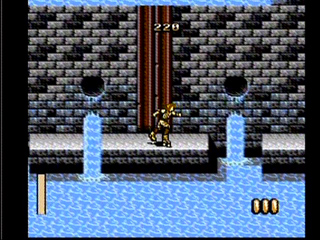
The game is very pretty in terms of the graphics. The presentation is very detailed and uses nice and bright colours. The only gripe I have to make is a very common thing among Konami games like Track and Field, and that’s the fact that none of the characters actually have faces. Just heads. It’s just creepy. Most of the characters have one solid colour palette that makes it look like their skin colour is a also the shade of that. They look like they came from Blades of Steel (Another Konami game). The music is great; however the songs are not very memorable by comparison to other Nintendo soundtracks.
Controls are simple. Directional pad moves the character, A to jump, B to punch. Controlling the character is a little bit more complicated. Since the character is supposed to be on roller-skates, it feels like you’re walking on ice, similar to the Ice stages in Super Mario Brothers 3. Because of this, it takes longer to get used to how the character moves on screen. And it doesn’t help that the first two obstacles you have to face are a multiple jump series between two death pits, and a ramp over a large death pit. Moving left and right is almost like an analog stick, as you have to hold down and let the character gain momentum to move. It’s pretty creative how it’s executed, but makes for some frustrating platforming. Jumping from stationary is next to impossible because of this. You need to gain speed in order to make jumps. If you go too fast, you can overshoot the platform. If you’re not going fast enough, you can miss the jump entirely. This can result into many shouts of anger fueled rage.
Each stage outside of 2 and 4 are broken up into two or more sub stages. The variety of locations consist of a street, a highway, a junkyard, a sewer, and a jungle. Yes, you are roller-skating in a dirt jungle. Many questions arise, one of which being “YOU’RE ROLLER SKATING IN A JUNGLE THAT IS COVERED IN DIRT!”. Surprisingly, no alligators in the jungle, or the sewer. Such a missed opportunity.
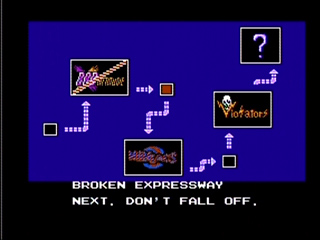
The layout of each stage is quite cumbersome. Some parts are longer than others. For example, the first stage, 1-1 is twice as long as 1-2, and 1-1 has two fighting sections compared to 1 in the latter. It makes it more discouraging to beat the first stage when you also realize there are no checkpoints in each sub stage. Thankfully they give you mercy when you beat a sub stage you don’t have to start at the very beginning from that point on. The game offers unlimited continues as well, so you don’t have to start over if you die afterwards. Without checkpoints inside the stages, however, you’re forced to complete all the challenges before moving on, which can get annoying. So, again the first stage as an example, you have to make all the jumps, dodge the potholes, hit the enemies, then do a combat segment, then hit several more grunts, dodge rolling barrels, maneuver around a tight path surrounded by death pits, dodge more barrels, then fight another collection of roller skating goons. It’s more complicated than the Eliminator in American Gladiators.
Because of the clunky controls and the cumbersome layout, the difficulty curve slopes pretty high quickly. The game relies heavily on trial and error game play, which means you will die a lot and have to learn how to avoid obstacles. Compare that to the previously mentioned Super Mario Brothers 3. The challenges come in small doses, and gradually you can learn most of the tricks and trades early. So by the time you reach a later stage, you are confident enough to play the stages for the first time and not encounter too much you haven’t seen. Here in Rollergames, things can jump from the screen at any time, like oil drums that come exactly in your way and leave you little time to react if you haven’t seen it. There’s even a narrow cliff in the jungle stage that breaks the ground at certain specific points and gives you very narrow room to react in time, leaving the margin of error really tight. I must have spent a couple hours on that one part alone. You have to learn the pattern in advance to advance. And with only 6 stages altogether, the game should be relatively short. But with certain jumps being a burden, it feels more like padding. By contrast to Mario 3 where completing a level made you feel like accomplished, when you finish a level in Rollergames, you felt lucky you did it. It’s one of my biggest gripes of the game.
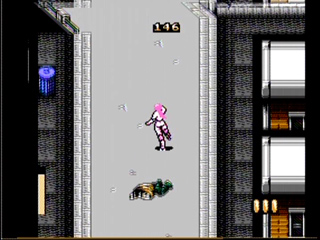
To summerize, Rollergames is essentially a Konami game, through and through. Every Konami game you ever played or owned for the N.E.S., roll it up into one big figure 8, throw it in a blender, garnish with parsley and serve. That’s this game. The graphics are Konami, the sound is Konami, the frustrating challenge is Konami, everything. Even the pause sound effect is the standard Konami sound. For a game that was released for the Nintendo in 1990, it just came out with so much as a whimper and a fade.
To be honest, though, no matter how difficult the game is, I still had a lot of fun with it. It has a lot of charm, the visuals are very nice, the challenge is there, and it handles pretty well once you get used to it. It’s an overlooked gem, and I know a lot of people already knew how good this game is. I only got so far as Stage 5-2 before quitting on account that my controller got thrown to the wall, but I may have to come back to it. I’m glad I got a chance to play it again later. You like the kind of difficult platformer games, then I definitely recommend it. It’s not a rage game, per se, but it’s definitely not a stress reliever.
That does it for the first of what will be many reviews to come. Join in next time, when I hope my Randomizer doesn’t give me any game with alligators. I’m sorry; I still can’t get over that piece of trivia. A freaking alligator pit? Really?
3 Responses to Randomizer – Rollergames (NES)